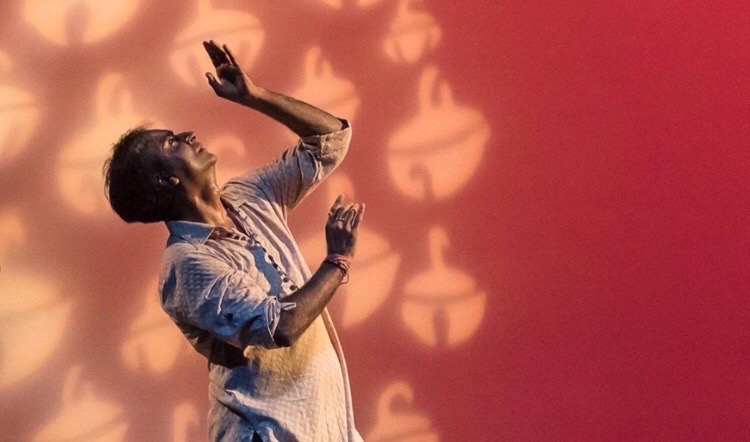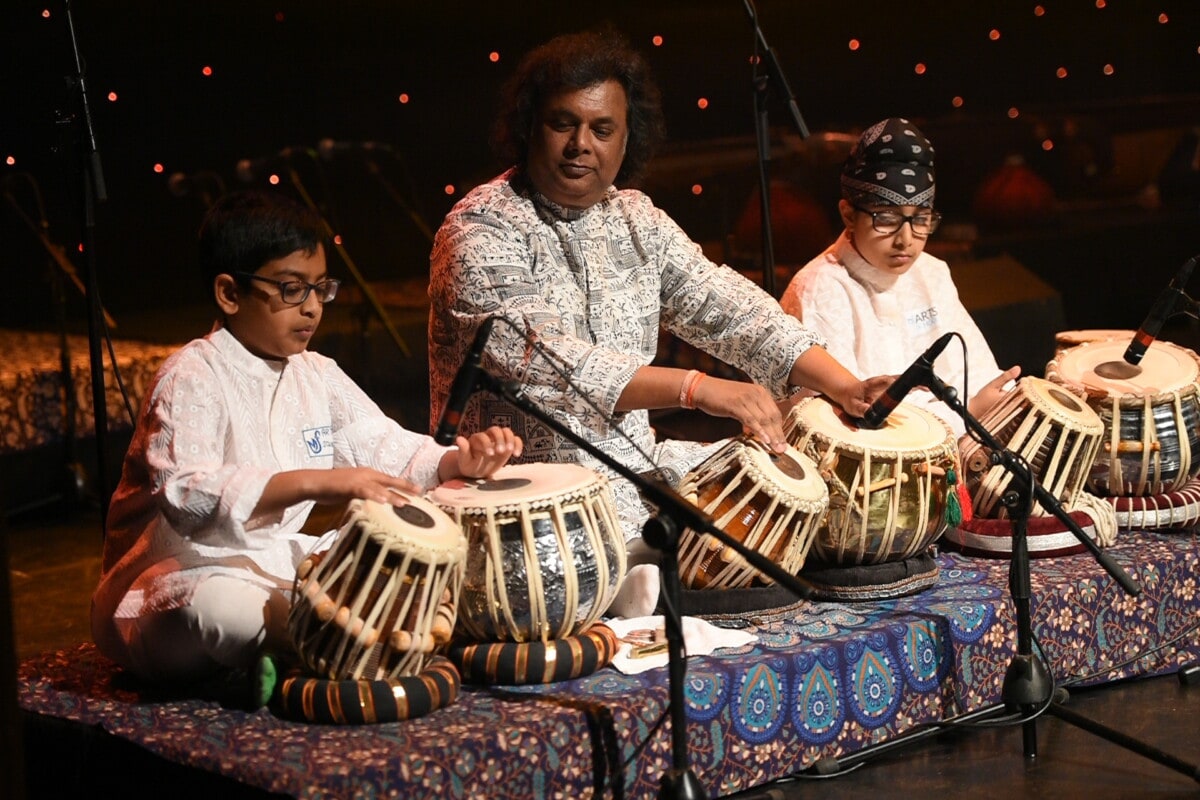This year, to celebrate Guru Purnima – or, Vyasa Purnima – we asked a group of Milap friends and artists to tell us about the significance of their Gurus.
Guru Purnima will this year take place on July 3rd. The day is a religious Hindu festival dedicated to offering respect to all spiritual, academic and creative gurus. It is celebrated as a festival in India, Nepal and Bhutan by Hindus, Jains and Buddhists.
In addition to the religious importance of the day, the festival holds great importance for Indian academics and scholars. Students celebrate the day by thanking their teachers, and by remembering past teachers and scholars.
Pandit Ranajit Sengupta
My Musical journey started at my home, as I took initial lessons as a kid on Mandolin & later on Guitar during my teens, from my own uncles. So learning music was fun, as I could learn anytime from them. But they had been very strict to me, and I was required to practice every day.
Later when I was in my mid-teens, I took Sarode as my main instrument, without knowing anything about the instrument, and the depth of Raga music. I am indebted to my Gurus Late Ustad Dhyanesh Khan & Ustad Aashish Khan, for showing me a different approach to music.
I believe you need a Guru as they show you the right path to continue your journey as a musician, throughout your life even when not with you physically.
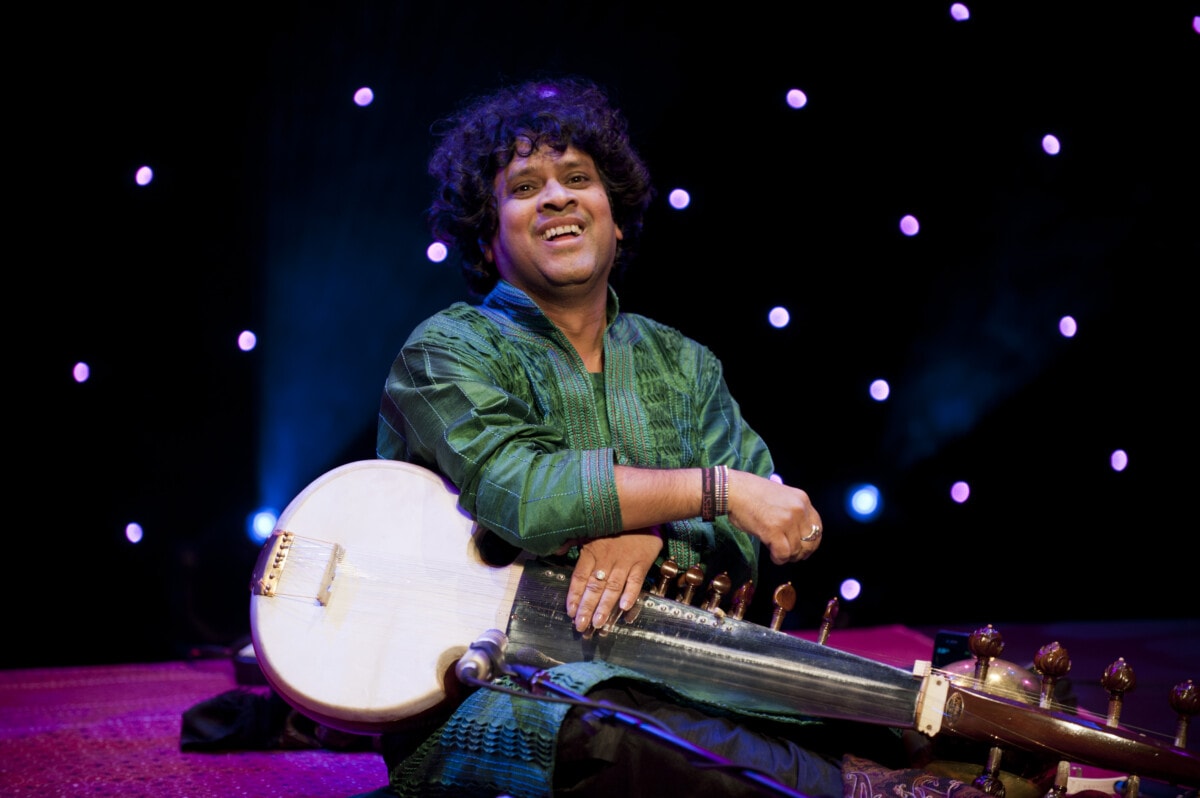
Santosh Nair
AN ENDURING JOURNEY OF BHARATANATYAM: MY EXPERIENCES AND RELATIONSHIPS WITH MY GURUS
My initiation into the captivating world of Bharatanatyam began under the loving guidance of my mother at a tender age. However, it was the invaluable mentorship of Late Guru V.S. Ramamoorthy and Guru Smt. Manjula Ramaswamy that truly shaped me both as a dancer and as an individual. Through their selfless teachings and unwavering support, they instilled in me the essence of Bharatanatyam and imparted profound life lessons. Furthermore, their profound influence led me to the talented Guru Smt. Priyadarshini Govind, who, with open arms, welcomed me into a realm of boundless creativity and critical thinking. In this narrative, I would like to share the profound impact my gurus have had on my artistic and personal journey.
Early influences
Under the compassionate tutelage of my mother, Bharatanatyam became an integral part of my upbringing. As I took my first steps into this art form, I discovered a world filled with rich cultural heritage and storytelling. My mother’s passion for Bharatanatyam kindled the flame within me, and her patient guidance fuelled my initial curiosity and determination.
The Guiding Light of Late Guru V.S. Ramamoorthy
At the age of five, my journey took a transformative turn when I came under the mentorship of the illustrious Late Guru V.S. Ramamoorthy. His profound knowledge, immense dedication, and unparalleled commitment to Bharatanatyam left an indelible mark on my artistic sensibilities. With unwavering patience, he nurtured my talent, instilling discipline and perseverance, which formed the foundation of my dance journey. His ability to seamlessly blend traditional techniques with innovative expressions broadened my horizons, allowing me to explore the vast realm of Bharatanatyam with renewed vigor.
Guru Smt. Manjula Ramaswamy: A Mentor for Life:
Guru Smt. Manjula Ramaswamy, an exceptional artist in her own right, became my guiding light as I embarked on this artistic expedition. Under her compassionate and insightful guidance, I not only learned the nuances of Bharatanatyam but also imbibed invaluable life lessons. Through her teachings, she exemplified the significance of selflessness, emphasizing the importance of sharing knowledge and experiences with others. Guru Manjula Ramaswamy’s unwavering support and mentorship served as a constant source of inspiration, encouraging me to strive for excellence while remaining grounded.
A Journey of Intellectual Exploration: Guru Smt. Priyadarshini Govind
Guided by the unwavering support of Guru Smt. Manjula Ramaswamy, I was fortunate to find myself in the esteemed presence of Guru Smt. Priyadarshini Govind. With a warm embrace and an open mind, she welcomed me into her world of dance, provoking thought and encouraging introspection. Priya aunty’s guidance enabled me to explore the depths of Bharatanatyam, pushing boundaries, and challenging traditional norms. Her emphasis on embracing innovation while respecting the art form’s roots broadened my perspective, allowing me to weave a unique artistic identity. One of the defining characteristics of my continuing journey under Priya aunty’s guidance was her emphasis on thinking and rethinking. She encouraged me to question preconceived notions, to challenge the status quo, and to constantly seek new perspectives. Through her insightful feedback and thought-provoking discussions, she fostered an environment of intellectual curiosity, where learning became an immersive and transformative experience.
Aunty helped me develop a holistic understanding of Bharatanatyam, encompassing its historical and cultural significance. Every class with aunty encouraged me to connect with the larger context of the art form, embracing its roots while exploring its contemporary relevance.
Beyond the realm of dance, my gurus taught me valuable life lessons. Their teachings instilled in me a deep sense of empathy, discipline, perseverance, and humility. They taught me the importance of patience, hard work, and dedication in both artistic pursuits and everyday life.
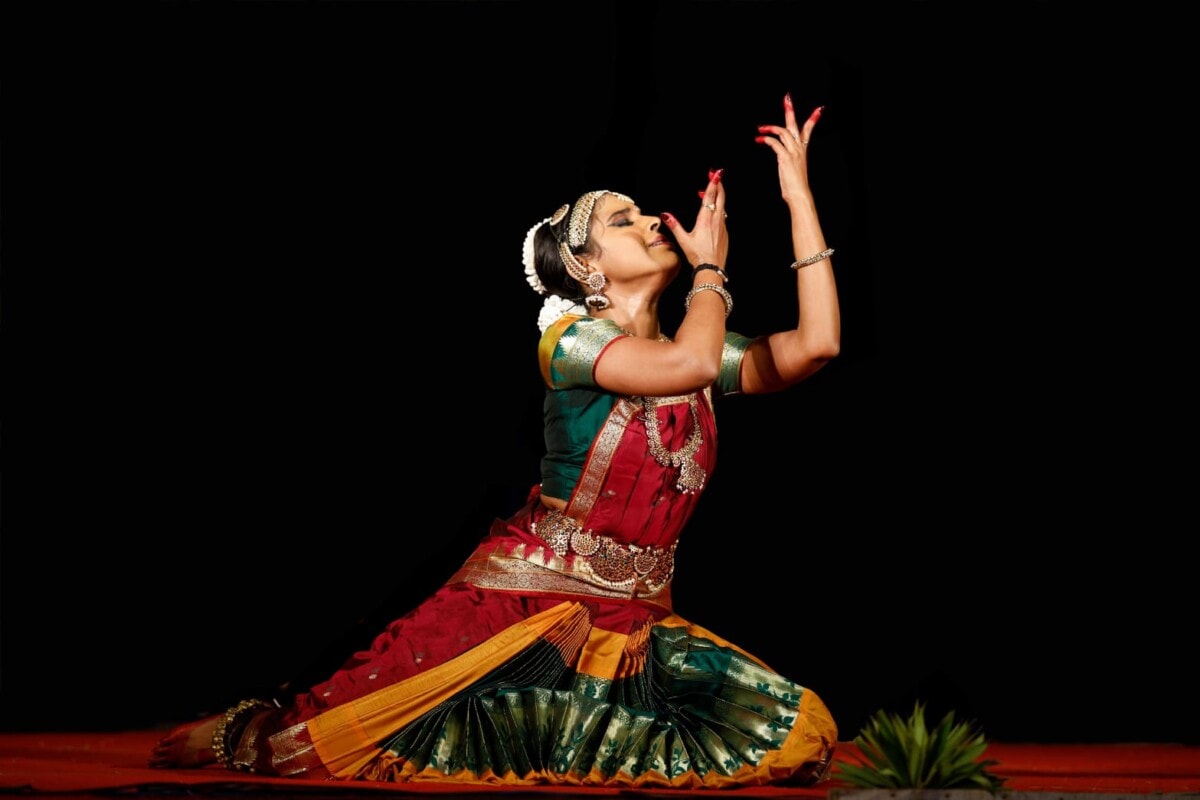
Shijith & Parvathy
- How has your guru influenced your artistic style and approach? We consider Kalakshetra and Smt Rukmini Devi as the guiding force that has fueled the passion within us on our artistic journey.
- Can you share a memorable anecdote or story about your interactions with your guru? We haven’t had the opportunity to have a direct interaction with Smt. Rukmini Devi. Sitting under the great Banyan tree and breathing the air in Kalakshetra, dancing her choreographies, understanding the ideas behind each of her work and soaking in that ambience are ways in which we interact with her.
- What specific techniques or teachings from your guru have had the most significant impact on your artistic growth? “Dance, sing….fill India with the beauty of drama and the grace of poetry…but more than all, let each student who comes and goes say….I can do more. I can fill my life with spiritual grace ” – Rukmini Devi. Bharatanatyam is our spiritual recourse.
- How do you maintain a strong connection with your guru despite geographical or time constraints? By dancing in abundance and striving to seek more. Every day is a new beginning…We are just a speck in this universe and there is so much to seek.
- In what ways has your guru inspired you to explore new artistic territories or take creative risks? Smt Rukmini Devi was way ahead of time. She believed in her artistic calling and explored new artistic territories which were not thought of in those days. She believed in Herself and she was guided by a strong conviction. Her vision was never time bound. Art is not meant to be a garland kept in the fridge. Its fragrance must spread everywhere.
- What qualities or characteristics do you admire most about your guru and strive to embody in your own artistic journey? Aesthetics, Discipline towards the art. Only one who has utmost discipline towards the art can become a disciple of the art.
- How has your guru’s guidance and mentorship shaped your understanding and interpretation of traditional or classical art forms? Traditional art forms are meant to be preserved and passed on responsibly. For this, we have to have a deep understanding of our roots, traditions, heritage, philosophy, spirituality and the emotion embedded in our classical art forms and pass it on to the next generation with the same spirit.
- Have you ever had the opportunity to collaborate or perform alongside your guru? If so, what was that experience like? Never. But we’ve danced her choreographies and been part of her magnum opus productions. Those moments have been uplifting and enriching experiences. But only with maturity and experience did we understand her thought process and vision. As a student, we would only see the outer beauty of a work but with time and maturity we delve deeper and come across moments that we never experienced as a young student. And that is the ultimate experience.
- Is there any particular phrase or mantra your Guru used which you remember often and live by? “Education without fear, Art without vulgarity, Beauty without Cruelty.”
- Can you describe the impact your guru has had on your personal and professional growth as an artist? Our learning at Kalakshetra has impacted us immensely in every sense. Athai’s ( Smt Rukmini Devi is fondly called Athai ) philosophies have influenced every aspect of our lives. She believed in holistic development as an artist and human being and not just being a mere dancer or singer. Whenever we think about Kalakshetra and Athai, this shloka comes to our mind –
ॐ सह नाववतु ।
सह नौ भुनक्तु ।
सह वीर्यं करवावहै ।
तेजस्वि नावधीतमस्तु मा विद्विषावहै ।
ॐ शान्तिः शान्तिः शान्तिः ॥
Transliteration
oṁ saha nāvavatu ।
saha nau bhunaktu ।
saha vīryaṁ karavāvahai ।
tejasvi nāvadhītamastu mā vidviṣāvahai ।
oṁ śāntiḥ śāntiḥ śāntiḥ
English Meaning
Om, May the Guru and the disciple be protected together
May we be nurtured together
May we work vigorously together
May our studies illuminate us
May there be no dislike between us
Let there be peace, peace, peace

Kousic Sen
- How has your guru influenced your artistic style and approach? I have had many teachers who have had different influences on my style and approach. This influence has also come from many others I have heard perform.
- Can you share a memorable anecdote or story about your interactions with your guru? He used to say that I should listen to everyone and all styles, to try to learn something new from them which I maintain till this day.
- How do you maintain a strong connection with your guru despite geographical or time constraints? I have stopped directly learning from my guru a long time ago, but I continue to learn from many others through YouTube and other medias.
- What qualities or characteristics do you admire most about your guru and strive to embody in your own artistic journey? He was very open to praise his students and uplift them. This form of praise is especially effective to younger students who are new to the craft.
- How has your guru’s guidance and mentorship shaped your understanding and interpretation of traditional or classical art forms? It was made very clear what the classical art form was at the time, but we were also told to be flexible to change, and that the classical art form evolves over time.
- Have you ever had the opportunity to collaborate or perform alongside your guru? If so, what was that experience like? I have performed with my gurus many times. It is always a very humbling experience.
- Is there any particular phrase or mantra your Guru used which you remember often and live by? Practice. Always. Don’t stop.
- Can you describe the impact your guru has had on your personal and professional growth as an artist? My gurus created the foundations for me, but it was up to me to keep working on the rest, and I continue to work on it.
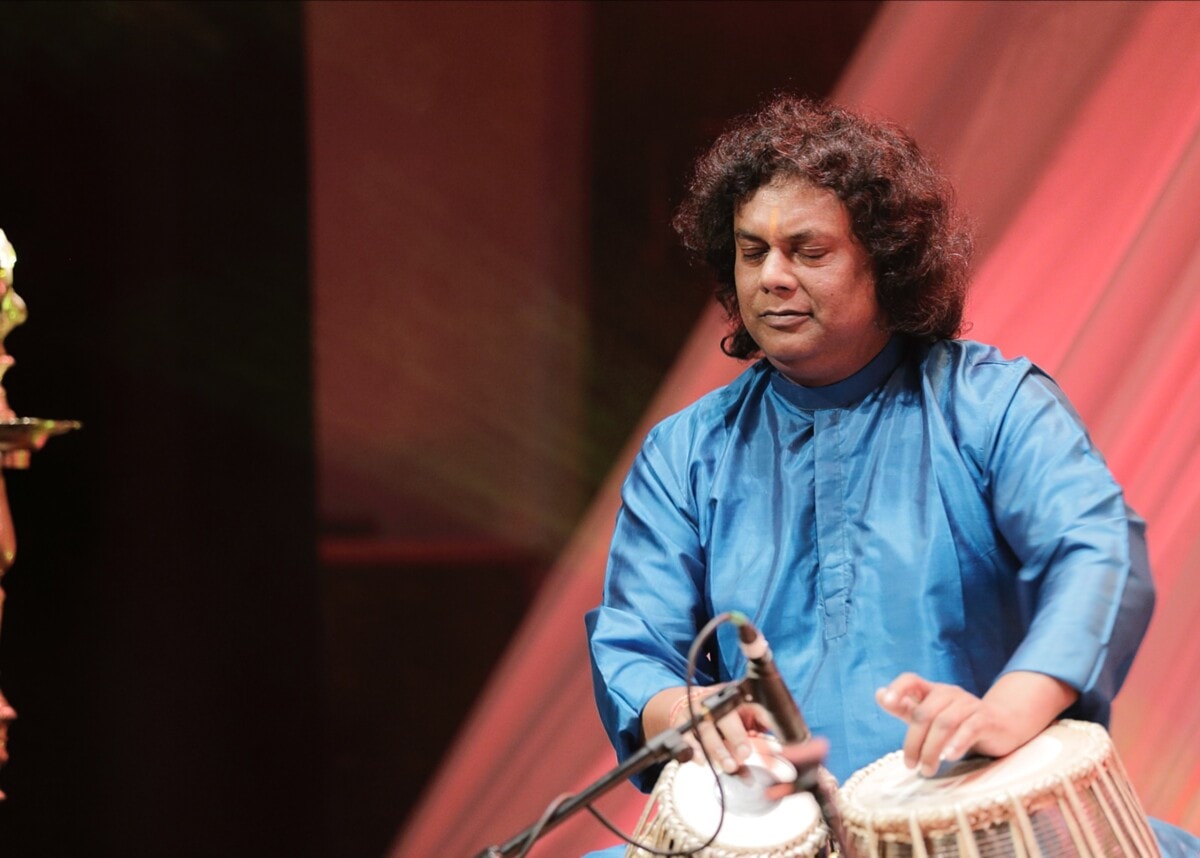
Prashant Shah
1. How has your guru influenced your artistic style and approach?
My training under the tutelage of my guru Kumiben (Kumudini Lakhia) involved rigorous technical training while also encouraging to use dance as a mode of self-expression to scratch beyond the surface of technique. She made me understand dance is beyond technique. She made me realise the importance of sensitivity and sensibility involved in any movement and rhythmic pattern too. My awareness of using the space and its possibilities of exploring it visually in Kathak dance form, both in traditional and contemporary ideas, are the result of my training under her.
2. Can you share a memorable anecdote or story about your interactions with your guru?
It’s difficult to point to one. But yes, I can definitely say one of her quotes which motivates me a lot whenever I am creating my new work is…
‘It’s good to be a bad original than to be a good xerox copy’…...
This gives me courage to attempt and create new movement patterns-new rhythmic patterns-new ideas, keeping intact the deeply rooted rich Kathak traditional technique as a base and foundation in any of my works.
3. What specific techniques or teachings from your guru have had the most significant impact on your artistic growth?
For me, one of the most important teachings I can feel is that……she made me realise that my body has to be my best friend. If I can’t relate to my body and if I don’t understand the sensitive approach of a particular movement when I am dancing, it wont make any sense to my choreography. She said ‘wear your movement’…It is your movement – your body. One has to constantly keep the communication hotline ON with one’s own body while creating because the body will right away give you a hint whether that particular movement or rhythm or idea or concept is meant for you or not. Because not everything looks good on everyone. Same logic applies to the color and clothes that we wear. We have to have a realistic approach when we create new works, all the time.
4. How do you maintain a strong connection with your guru despite geographical or time constraints?
I think distance doesn’t matter to me at all. I have spent so many years with her that every time I create something, I feel that her teachings with respect to kathak technique, choreography, music awareness, use of lights, costumes have a great influence and impact in my Kathak journey. At the same time, I know that if I feel like talking to her regarding any of my new works and getting her advice on my new works, she is just one phone call away 🙂
5. In what ways has your guru inspired you to explore new artistic territories or take creative risks?
As I said she always said ‘Just Dance’….don’t worry about what others will feel about your creative process or creations. Even if it is not applauded or appreciated by the audience, it’s okay. Keep evolving and Keep presenting your work with your own artistic knowledge . Sometimes, it connects to the audience and sometimes it doesn’t. It’s okay….For my Kathak journey I always feel that….. Destination is not important, the Journey is important 🙂 One should enjoy the journey 🙂
6. What qualities or characteristics do you admire most about your guru and strive to embody in your own artistic journey?
I have seen Kumiben open to so many suggestions when she creates something. Even when we were learning any choreography from her or when we were in her class, there was always room of questioning. She always encouraged us to be inquisitive while getting trained under her. That’s an amazing quality in her. And I always try my best to teach my students here in New York and all over the US that they should feel free too. This way they will relate to the work more rather than follow blindly.
7. How has your guru’s guidance and mentorship shaped your understanding and interpretation of traditional or classical art forms?
Kumiben always made sure that our traditional hardcore training in Kathak was not compromised at all. She always said unless and until your tatkaar chakkars and todas tukdas and tihaais are not practiced everyday for hours, you can’t do justice to any new works which involve any contemporary ideas or themes. Tradition is the base of everything. To me, Tradition means strong roots – and we need to make sure that we are always attached with our roots even while attempting any contemporary works.
8. Have you ever had the opportunity to collaborate or perform alongside your guru? If so, what was that experience like?
No. I wish I had one 🙂
9. Is there any particular phrase or mantra your Guru used which you remember often and live by?
“Dance…let us dance…Dance is beyond gender, race, religion, color….Dance gives us identity….. so let’s just dance “
10. Can you describe the impact your guru has had on your personal and professional growth as an artist?
Words are never going to be enough to mention how much she has impacted my professional growth as an artist. I feel blessed that I could learn Kathak from Kumiben in this life.
